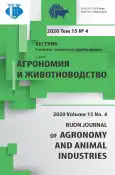Diagnosis of potato rot nematode Ditylenchus destructor using PCR-RFLP
- 作者: Mahmoudi N.1, Pakina E.N.1, Limantceva L.A.2, Ivanov A.V.2
-
隶属关系:
- Peoples’ Friendship University of Russia (RUDN University)
- All-Russian Plant Quarantine Center
- 期: 卷 15, 编号 4 (2020)
- 页面: 353-362
- 栏目: Plant protection
- URL: https://journal-vniispk.ru/2312-797X/article/view/316909
- DOI: https://doi.org/10.22363/2312-797X-2020-15-4-353-362
- ID: 316909
如何引用文章
全文:
详细
During an investigation of nematodes in the Moscow region of Russia in 2019, a known species Ditylenchus destructor was recovered from tubers of potato plants. The genus Destructor is one of the most problematic genera of plant-parasitic nematodes. The numerous species reported for this genus have been cited from various sources. Due to the morphological similarity of many species and the lack of separation characteristics, the identification of D. destructor is difficult. Molecular taxonomy and phylogeny were used to confirm the identification. In the current study, PCR-RFLP illustrative models for the amplification of the ITS-rRNA gene were provided with two enzymes that could recognize D. destructor in potato tubers. Analysis of the rDNA sequences spanning both ITS1-ITS2 regions was carried out on the collected populations. The digestion of the PCR product of the ITS1-5.8S-ITS2 region with the enzyme TaqI produced three fragments; 100, 190, 550, and with Tru1I, two fragments were produced; 300 and 480 bp. The obtained DNA sequences were compared with those DNA sequences deposited in GenBank of populations isolated in other countries. The results showed no distinction between populations isolated from different host plant species, including populations found in the Russian Federation. New sequences from ITS-rRNA were deposited in the GenBank under accession number MN122076, MN658597, MN658599, MN658637, MN658638.
作者简介
Niloufar Mahmoudi
Peoples’ Friendship University of Russia (RUDN University)
编辑信件的主要联系方式.
Email: niloofarmahmoodi@ymail.com
PhD candidate, Department of Agrobiotechnology, Agrarian and Technological Institute
8/2, Miklukho-Maklaya st., Moscow, 117198, Russian FederationElena Pakina
Peoples’ Friendship University of Russia (RUDN University)
Email: e-pakina@yandex.ru
Associate Professor, Candidate of Biological Sciences, Agro-Biotechnological Department, Agrarian and Technological Institute
8/2, Miklukho-Maklaya st., Moscow, 117198, Russian FederationLiudmila Limantceva
All-Russian Plant Quarantine Center
Email: Limantseva.ludmila@vniikr.ru
Senior Scientist
32, Pogranichnaya st., Bykovo vill., 140150, Ramenskoye, Moscow region, Russian FederationAnton Ivanov
All-Russian Plant Quarantine Center
Email: Ivanov.anton@vniikr.ru
Junior Researcher
32, Pogranichnaya st., Bykovo vill., 140150, Ramenskoye, Moscow region, Russian Federation参考
- Bae CH, Szalanski AL, Robbins RT. Genetic variation of Hoplolaimus columbus populations in the United States using PCR-RFLP analysis of nuclear rDNA ITS regions. Journal of nematology. 2009; 41(3):187-193.
- Ding SW, Yang SH, Wu WJ, Xie H, Xu CL. Rapid diagnosis of Ditylenchus destructor by loopmediated isothermal amplification assay based on 28S rRNA sequences. European Journal of Plant Pathology. 2019; 153(4):1165-1175. doi: 10.1007/s10658-018-01633-7
- Jeszke A, Dobosz R, Obrępalska-Stęplowska A. A fast and sensitive method for the simultaneous identification of three important nematode species of the genus Ditylenchus. Pest management science. 2015;7 1(2):243-249. doi: 10.1002/ps.3788
- Ji L, Wang JC, Yang XL, Huang GM, Lin MS. PCR-RFLP patterns for differentiation of three Ditylenchus species. Journal of Nanjing Agricultural University. 2006; 29(3):39-43. doi: 10.7685/j.issn.10002030.2006.03.008
- Mahmoudi N, Naserzadeh Y, Pakina EN, Limantceva LA, Nejad DK. Molecular identification of Ditylenchus destructor nematode with PCR Species-Specific primers in the Moscow region. RUDN Journal of Agronomy and Animal Industries. 2019; 14(4):430-436. doi: 10.22363/2312-797X-2019-14-4-430-436
- Liu B, Mei YY, Zheng JW. Species-specific detection of inter-populations of Ditylenchus destructor. Journal of Zhejiang University (Agriculture & Life Sciences). 2007; 33:490-496
- Mahmoudi N, Pridannikov M, Zargar M, Naserzadeh Y, Limantceva L, Pakina E. Molecular diagnostics of Ditylenchus destructor based on the ITSrDNA from Iran and Russia Federation. Research on Crops. 2020; 21(1):151-155. doi: 10.31830/2348-7542.2020.025
- Marek M, Zouhar M, Douda O, Mazakova J, Rysanek P. Bioinformatics-assisted characterization of the ITS1-5· 8S-ITS2 segments of nuclear rRNA gene clusters, and its exploitation in molecular diagnostics of European crop-parasitic nematodes of the genus Ditylenchus. Plant Pathology. 2010; 59(5):931-943. doi: 10.1111/j.1365-3059.2010.02322.x
- Oliveira CM, Monteiro AR, Blok VC. Morphological and molecular diagnostics for plant-parasitic nematodes: working together to get the identification done. Tropical Plant Pathology. 2011; 36(2): 65-73. doi: 10.1590/S1982-56762011000200001
- Mizen KA, Caubel G, Plowright RA. Ditylenchus species. In: Cook R, Starr JL, Bridge J. (eds.) Plant resistance to parasitic nematodes. CABI Publishing; 2002. p.107-139.
- Powers TO, Szalanski AL, Mullin PG, Harris TS, Bertozzi T, Griesbach JA. Identification of seed gall nematodes of agronomic and regulatory concern with PCR-RFLP of ITS1. Journal of Nematology. 2001; 33(4):191-194.
- Smith IM, Mc Namara DG, Scott PR, Harris KM. Quarantine pests for Europe. Cambridge: University Press; 1992.
- Subbotin SA, Madani M, Krall E, Sturhan D, Moens M. Molecular diagnostics, taxonomy, and phylogeny of the stem nematode Ditylenchus dipsaci species complex based on the sequences of the internal transcribed spacer-rDNA. Phytopathology. 2005; 95(11):1308-1315. doi: 10.1094/PHYTO-95-1308.
- Deimi AM, Zheng J, Chizhov VN, Subbotin SA. Length variation and repetitive sequences of internal transcribed spacer of ribosomal RNA gene, diagnostics and relationships of populations of potato rot nematode, Ditylenchus destructor Thorne, 1945 (Tylenchida: Anguinidae). Nematology. 2011; 13(7):773-785. doi: 10.1163/138855410X551923
- Thorne G. Ditylenchus destructor n. sp. the potato rot nematode, and Ditylenchus dipsaci (Kühn, 1857) Filipjev, 1936, the teasel nematode (Nematoda: Tylenchidae). Proceedings of the helminthological Society of Washington. 1945; 12(2):27-34.
- Wan F, Peng DL, Yang YW, He YQ. Species specific molecular diagnosis of Ditylenchus destructor populations occurring in China. Acta Phytopathologica Sinica. 2008; 38(3):263-270.
- Wendt KR, Swart A, Vrain TC, Webster JM. Ditylenchus africanus sp. N. from South Africa; a morphological and molecular characterization. Fundamental and Applied Nematology. 1995; 18(3):241-250.
- Willett DS, Martini X, Stelinski LL. Chemoecology and Behavior of Parasitic Nematode - Host Interactions: Implications for Management. In: Tabata J. (ed.) Chemical Ecology of Insects. Boca Raton: CRC Press; 2018. p.91-113. doi: 10.1201/9781351228398.
补充文件










